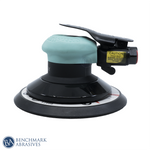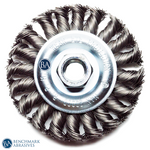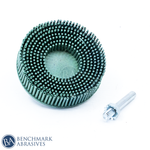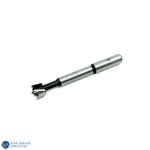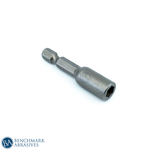
Customizing Your Ride: Automotive Detailing DIY With Abrasives

Most individuals consider cleaning their automobiles more of a chore than a successful task. Cleansing an entire car is a labor-intensive, time-consuming, and highly tiresome task that is frequently compared to punishment rather than enjoyment.
Like any "detail-oriented" project, the hardest part is usually figuring out where to begin and dedicating the necessary time to thoroughly clean every nook and cranny of an automobile. This is precisely why our assistance is available.
AUTOMOTIVE DETAILING: WHAT IS IT?
Since auto detailing entails a "detailed" cleaning process and frequently includes restoring damaged components, it is a self-explanatory operation. On the outside, detailing shields paint, glass, and body parts from UV radiation, impurities, and damage from driving.
The detailing industry has grown to be a multibillion-dollar sector today, and the thousands of distinct detailing products that power it each have their own particular genetic foundation, marketing strategy, and distribution network. To put the enormity of this operation into perspective, the auto detailing business in the United States alone was estimated to be worth USD 10.3 billion in 2020, after the industry suffered greatly due to COVID-19.
ADDING EXTERIOR DETAILS TO A VEHICLE
If someone chooses to detail their car, they will probably adhere to the following general rules:
CLEAN THE EXTERIOR –
The first stage in car detailing should always be a thorough cleaning using high-quality detailing supplies and a reliable water source. This ensures that any surface gunk—such as dirt, debris, road filth, pollen, or other residue—is removed and reveals any significant problems hiding below the surface. To lessen the chance of scratching or damaging the surface, automobile owners should do this step using a low-pH car wash shampoo and a microfiber towel or wash mitt.
PROTECT THE EXTERIOR –
Although a thorough car wash is essential for removing surface debris, car detailing usually entails applying surface protective coatings, which take it beyond a critical scrub. You can use tire dressing, ceramic coatings, car wax, paint sealants, clear bras, vinyl wrap, paint protection films, and other protective products. Tire dressing improves other external components, such as tires. Glass cleaner is another common application for automobile glass cleaning.
Quick Tip: You have two options for doing an external detailing job: you may acquire an all-in-one DIY detailing kit or piece together a unique arrangement by purchasing various automobile cleaning supplies.
Usually, the first step in protecting automotive paint is to prepare it with a clay bar.
Experts in car detailing advise starting with the wheels and cleaning them with tire and wheel-certified brushes and wheel cleaners.
Many auto owners believe that all it takes to clean their automobiles is to change the air fresheners or apply tire shine. Yes, you could go all out and get a powerful pressure washer, many kinds of synthetic car wash shampoos, and some luxurious car wash brushes, but more than these items alone will be needed to ensure outstanding results. The top auto detailers in the world concur that having the correct tool is not enough to make an automobile look flawless; you also need a hyper-focused work ethic, patience, and practice. It never hurts to have a cold six-pack on hand as well.
THE PROCESS OF DETAILING THE CAR
Car detailing is a relatively easy task. However, if one uses the incorrect supplies or follows the wrong techniques, even cleaning a car might do severe damage. However, half the battle is won when one knows what items to use and the necessary actions.
Now that you know this information, let's move on to another crucial action to maintain the pristine appearance of your car's finish: frequently wash it. And carry it out correctly.
When contaminants like dirt, mud, road filth, bird turds, bug guts, pollen, deicers, and sap are left to sit for an extended period, they gradually soak into an automobile's clear coat. You will only end up hurting yourself in the long run if you are lazy, so remember the six golden laws of vehicle washing and try to scrub that machine down once a week.
AVOID WASHING YOUR CAR IN THE DIRECT SUN
Only some detailing products will work well in the sun or on a heated surface. Heat also causes soap and water to dry more quickly, which results in lingering water stains and streaks. Work inside or in the shade whenever possible, and only after the outside surfaces of the car are entirely cool to the touch.
AVOID CROSS-CONTAMINATION
During a car wash, cross-contamination happens when the same products are used for each step of the cleaning procedure. Therefore, avoid using the same supplies (towels, brushes, buckets, water, etc.) in different car regions or for other purposes. You want to avoid transferring dirt or grime from one area of the car to another, nor should you scrub a reasonably clean area with a dirty microfiber mitt. This is especially crucial to remember while cleaning places that get unusually dirty, such as the wheels, bumpers, lower rocker panels, and exhaust ports.
APPLY THE TWO-BUCKET-AND-A-BEER METHODS
Cross-contamination can be reduced by often emptying your water and not using the same cloth or glove on every surface, but it's equally important to use the two buckets and a beer method. You can establish a safe spot to submerge that dirty sponge between scrubbing by keeping one bucket for rinse water and another for sudsy H2O. This will help keep the contaminants in the bucket of soapy shampoo at bay.
MAKE YOUR WAY DOWN FROM THE TOP
An automobile's bottom body is in direct contact with road debris, and you don't want that dirt to transfer to the higher, cleaner parts of the car. Nevertheless, starting with your rims and tires is usually a good idea—don't do it with soap and water. The dirtiest area of the automobile will receive a concentrated blast if you use a reliable spray-on and rinse-off chemical approved for the wheels you roll atop. Next, thoroughly clean the car, utilizing a different scrubbing agent on the wheels and tires' surfaces to prevent cross-contamination.
USE LUBRICATION ALWAYS
Not just our naughty bits benefit from a little lubrication when friction is present. Besides a mild cleaning with an incredibly soft microfiber dusting cloth, car paint and a clear coat need something slick to avoid scratches.
GET THE APPROPRIATE TOWELS AND SUPPLIES
As previously stated, washing a car's exterior using sponges and regular cloth wash towels is like using a 120-grit sandpaper in the shower. Sure, it will exfoliate, but at what expense?
Invest a small amount of money in some luxurious microfiber towels and a wash mitt for cleaning and drying your automobile since these things will significantly lower the chance of surface scratches. Order a pH-balanced auto shampoo while you're at it, too, since regular dishwashing liquid may severely damage a car's clear coat in addition to doing a terrible job of bacon grease.
APPROPRIATE WAYS TO WASH YOUR VEHICLE (STEP-BY-STEP)
Despite what many people think, you don't have to wash your car every week. The likelihood of causing damage to your car's external surfaces increases significantly each time you scrub it, mainly if you are unfamiliar with the hand-wash method or are using the incorrect technique. This is heavily influenced by the amount of dirt your car accumulates each week and the type of driving conditions it experiences. Here's a rough outline of what must occur for your vehicle to receive a safe cleaning.
STEP 1: ASSEMBLE YOUR SUPPLIES
After acquiring and stocking up on cleaning supplies, relocate everything you intend to use to the designated location for cleaning the car. By now, your two buckets and a beer setup should be ready. Rinse the filthy wash mitt or cloth in the first bucket and save the second bucket with the soapy H2O solution for dipping.
Additionally, you should ensure you have an abundance of microfiber cloths, two or three wash mitts, a garden hose with a sprayer wand, and a soft scrubbing brush for the tires and wheels. Additionally, you should ensure that your water source is neutral because using incorrect tap water might have various adverse effects.
STEP 2: APPLY IT AS THOUGH IT WERE YOUR OWN
Always remember to stay out of direct sunlight at all times and spray your car with water until all visible debris, pollen, bird poop, or other types of filth have been rinsed away. Additionally, you should stream the entire car in one sitting, starting at the top and moving down. If the car's tires and wheels were dirty, you would start there to avoid getting dirt on the freshly washed areas around them. Otherwise, you would start with the lower part of the car.
Unfortunately, many people will skip this first rinse step to go right to the scrub, which pushes surface impurities across the glass and clear coat and seriously damages the surface. Scratches and swirl marks can be minimized with a quick spray-down.
STEP 3: GO FOR THE RUBBER AND ROLLERS FIRST
Because so many different types of contaminants, including mud, road salt, brake dust, and asphalt grime, are in direct contact with the moving surfaces of wheels and tires, they are typically the dirtiest parts of an automobile. Because of this, it is essential that you start by cleaning all four of these corners, particularly if you last detailed the car a long time ago or if you have just got back from an intense 4x4 mud-slinging excursion.
Just use a tire and wheel cleaner that you spray on and then rinse off. Additionally, wash everything out after letting the mixture sit for the suggested amount of time before giving your tires a thorough scrub to remove any lingering dirt. Here's when a sudsy wheel sponge or brush comes in handy, especially if it's tiny and can reach places inside the alloy wheel that are difficult to achieve.
Quick Tip: Before using your wheel wash bucket for another part of your regular car wash, thoroughly rinse it. Apart from undercarriage and engine bay grime, wheel and tire pollutants are usually the dirtiest parts of an automobile.
STEP 4: TIME FOR TWO BUCKETS AND A BEER
Pour the suggested amount of auto shampoo from the manufacturer into one of the buckets, then fill it with water and run water through both buckets while enjoying your favorite beverage. After it's loaded, take out your wash mitt or microfiber cloth and proceed as follows.
- Give the entire car a thorough water spray to ensure no surface is left with loose pollutants.
- Soak the cloth or wash the mitt in soapy water. After it's completely saturated, wring it over the area you want to clean. This serves as a pre-soak, lubricating the surface even more and enabling the shampoo to remove any debris that may have become lodged there.
- Scrub the car, paying attention to one region at a time when the whole thing is covered in sudsy water. Always begin on the roof and work your way down, removing any impurities with your mitt by regularly dipping it in the rinse bucket. Then, if needed, absorb additional sudsy water.
- Make sure you wash in straight, overlapping lines as you scrub, not in circles, which can result in swirl marks showing. Be careful on this first pass since you don't want to grind any particles into the glass or clear coat after this initial scrubbing session, which will likely yield tons of debris.
- The water in the rinse bucket may have rapidly turned murky or contaminated with dirt, depending on how dirty the car is. If so, dispose of the tainted water and fill the bucket with clean water. Examining the quality of the soapy H20 bucket is also a good idea since deeply buried pollutants can still find their way into this sudsy solution even when a preliminary rinse bucket is in use.
- Before going to the following location, use a hose or pressure washer to rinse off the scrubbed section or body panel. Use a top-to-bottom technique for rinsing, and move fast to avoid soap drying out. You can prevent residue soap solidifying on the surface and water stains by always keeping the entire car wet.
- After your initial wash and rinse, you'll be able to determine whether challenging areas need a little more "coaxing" to be securely removed from the surface. While some advocate using a chemical "bug and tar remover" procedure that is quick and simple, others maintain that using a gradual, soapy approach is the safest. During the detailing process, surface marring frequently happens when dealing with sticky or deeply entrenched pollutants. Therefore, use caution when using any approach.
- After securely lifting any remaining debris and stubborn stains, empty the water from both buckets, rinse your wash mitt or towel and perform the complete top-to-bottom scrub-down process using new soap and water in each bucket. A few spots were either overlooked or needed more attention, so doing this second pass will ensure that any missed areas are covered.
STEP 5: ALLOW IT TO AIR DRY
No matter what the label on your automotive shampoo advises, letting a car air dry completely will inevitably result in watermarks and streaks. While others may brag about using leaf blowers or compressed air, they usually follow this water dispersion method with a thorough microfiber wipe-down, fully aware that this procedure probably calls for multiple fluffy towels.
When finished, this wipe-down will have not only eliminated any possible water stains or pooling problems but it will have also revealed any obstinate pollutants, designating them as
STEP 6: IT'S TIME TO INDULGE IN A LITTLE CLAY BAR
You will be surprised if you have never used a clay bar or detailing mitt. Since both solutions have the identical goal of smoothing your car's surface, their clarity and luster are unmatched.
The powerful clay bar is the primary target for the following tool in your detailing utility belt.
We prefer detailed mitts because they are readily cleaned during or after use and may be used often. Conversely, clay is meant to be used just once and needs to be thrown away if it falls to the ground. A clay mitt also fits over your hand, which makes it more convenient to use and grip. They can also cover a wider surface area because they are often more significant.
The four most essential steps in clay barring or detailing a car with a mitt are as follows: the process is straightforward.
- Apply your detailing spray or lubricant to the painted surface, tiny sections at a time. If you're using a clay mitt, treat the palm surface of the mitt as well to make sure it glides smoothly.
- Apply a light crosshatch pattern to the surface using the clay mitt. Initially, there will be some resistance, but as you move the mitt, you'll find it more straightforward to manipulate. This is beneficial. It indicates that you are cleaning the outside of your car with tiny surface impurities.
- After using the clay bar or mitt to clean the area you just finished, take a fresh microfiber towel and wipe it down. Using your fingertips, feel the surface and compare it with the area you will two. Surfaces should feel very different in terms of slickness.
- Apply the techniques above to every part of the car, focusing on a single panel or segment and ensuring the surface is consistently well-lubricated.
STEP 7: BUFF YOUR VEHICLE
A car's overall appearance can be significantly improved by polishing or buffing its paint. That being stated, you will only need to shine a vehicle if required, usually at the end of a detailed service or before a ceramic coating is applied. Compared to a conventional hand-polishing pad, using a powered buffer will speed up the process significantly and allow you to adjust the speed as needed. Just take care not to concentrate too much on one spot, or you risk damaging the car's clear coat.
MISTAKES TO AVOID WHEN IT COMES TO AUTO DETAILING
Speaking of errors, there are a number of them that might be made when detailing on cleaning day. Although everyone has different tastes in products and detailing methods, the following faults are the most typical and should be avoided entirely.
- USING THE WRONG CLEANING CLOTH OR THE SAME CLOTH ON ALL SURFACES.
The days of sponges with two sides and scrub wire brushes are long gone. Purchase some high-quality microfiber cloths and a microfiber mitt. Remember to use distinct microfiber washing and drying agents in separate places. Something nasty from your exhaust smeared across the surface of your perfectly polished clear coat is the last thing you want to see.
- WASHING IN THE HEAT OR UNDER DIRECT SUNLIGHT.
Always work indoors or in the shade because most detailing, aftercare, and protection solutions react negatively in direct sunlight or near a heated body panel. Additionally, this will lessen the possibility of soap residue and water spotting sticking to surfaces.
- USING DISH SOAP OR HOUSEHOLD CLEANING PRODUCTS
We know that home cleaning supplies are reasonably priced and easily accessible. We also recognize that you need a quick remedy because you are out of detailing shampoo. However, there's a reason dish soap still has the word "dish" rather than "car" and why automotive shampoo was created. Your clear coat will be consumed by this crap more quickly than anything else. Therefore, if you must decide between washing your car from top to bottom with dish soap and waiting it out, go for the first option.
- USING THE SAME BUCKET FOR BOTH RINSING AND SOAP.
When washing a car, you should NEVER use one bucket; always use two. Fill the first with sudsy vehicle shampoo and the second with water obtained safely for rinsing.
Always place your used wash mitt or microfiber cloth in the pure H20 bucket before dipping it into the soapy solution to minimize cross-contamination.
- TYRE AND WHEELS CLEANING LAST.
When you wash a wheel or tire, you will likely splatter brake dust and road filth on nearby surfaces. Prioritize cleaning the rubber and rollers before tackling the remaining parts of the car. When the detailing procedure is almost over, you can always give them one last go-around with some detailing chemicals and a microfiber cloth for that final touch.












